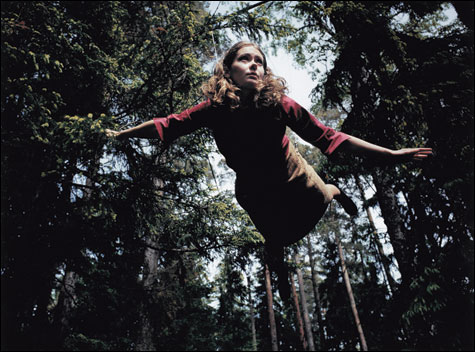Sound and video at MIT, “Eyewitness” at Axiom, Carolee Schneemann at Pierre Menard, and Kaspar König at the Sackler
By RANDI HOPKINS | October 1, 2007

Eija-Liisa Ahtila, The House |
| “Sounding The Subject” and “Video Trajectories” at MIT List Visual Arts Center, 20 Ames St, Cambridge | October 12–December 30 | 617.253.4680 | “Eyewitness” at Axiom Gallery, 141 Green St, Boston | October 12–December 1 | 617.953.6413 | “Carolee Schneemann” at Pierre Menard Gallery, 10 Arrow St, Cambridge | October 12–November 25| 617.868.2033 | Kaspar König speaks at Arthur M. Sackler Museum Lecture Hall, 485 Broadway, Cambridge | October 11 at 6 pm | 617.495.9400 |
Sound is all around: pop music acts as a hair trigger for memory (and a slightly unnerving background for grocery shopping); we hear voices we can’t place, silence we can’t ignore, noises we can’t tune out. The subjectivity of our experience of sound and the recent history of art that joins sound and image are the topics of two related shows opening at MIT’s List Visual Art Center on October 12: “SOUNDING THE SUBJECT” and “VIDEO TRAJECTORIES: SELECTIONS FROM THE PAMELA AND RICHARD KRAMLICH COLLECTION AND THE NEW ART TRUST.” Organized by Daniel Birnbaum and Mechtild Widrich, “Sounding the Subject” features work by Eija-Liisa Ahtila, Stan Douglas, David Hammons, Nam June Paik, and Pipilotti Rist that considers aural issues — from a layered look at a free-jazz concert to an uncanny listen-in on the voices of psychosis. Organized by Caroline Jones, “Video Trajectories” takes the form of a video library, offering a host of works from the 1960s to the early 2000s by artists including Dara Birnbaum, Dan Graham, Joan Jonas, Paul McCarthy and Mike Kelley, Bruce Nauman, Richard Serra, and Jane and Louis Wilson.The political and psychological implications of being a passive viewer — of art, war, genocide, immigration issues . . . whatever we watch — are examined in “EYEWITNESS: DENISE MARIKA AND THINK AGAIN,” which opens at Axiom Gallery on October 12. “Eyewitness” pairs Marika’s new video, Downrush, which examines the viewer’s role as witness, with a Think Again (S.A. Bachman and David John Attyah) installation, Salt in the Wound (The NAFTA Effect), that addresses anti-immigrant rhetoric and draws attention to current debates on immigration reform.

What we now know as performance art was uncharted territory in the early 1960s, when Carolee Schneeman began to cover her unclothed self in grease, chalk, and plastic and perform in created environments, exploring sex, gender, bodies, and art. Curated by Heide Hatry and opening at the Pierre Menard Gallery in Harvard Square on October 12, “CAROLEE SCHNEEMANN” presents new work along with early, rarely seen videos including the erotic Meat Joy (1964) and Fuses (1965).
Kaspar König, director of the Museum Ludwig in Cologne since 2000, has played a major role in contemporary art for more than four decades. In 1977, he co-founded “Sculpture Projects Münster,” an international exhibition of contemporary public sculpture presented every 10 years in that German university town. König talks about his experience in a lecture, “KASPAR KÖNIG: NOT TO OCCUPY A PLACE, BUT TO CREATE SPACE,” at Harvard’s Sackler Museum on October 11; the talk is free, but parking may be tight — it’s inauguration weekend at Harvard.
On the Web
MIT List Visual Arts Center: //web.mit.edu/lvac
Axiom Gallery: www.axiomart.org
Pierre Menard Gallery: www.pierremenardgallery.com
Arthur M. Sackler Museum Lecture Hall: www.artmuseums.harvard.edu
 Topics
Topics:
Museum And Gallery
, Carolee Schneemann, Eija-Liisa Ahtila, Visual Arts, More  , Carolee Schneemann, Eija-Liisa Ahtila, Visual Arts, Denise Marika, MIT List Visual Arts Center, Arthur M. Sackler Museum, Immigration, Domestic Policy, Entertainment, Immigration Policy, Less
, Carolee Schneemann, Eija-Liisa Ahtila, Visual Arts, Denise Marika, MIT List Visual Arts Center, Arthur M. Sackler Museum, Immigration, Domestic Policy, Entertainment, Immigration Policy, Less 